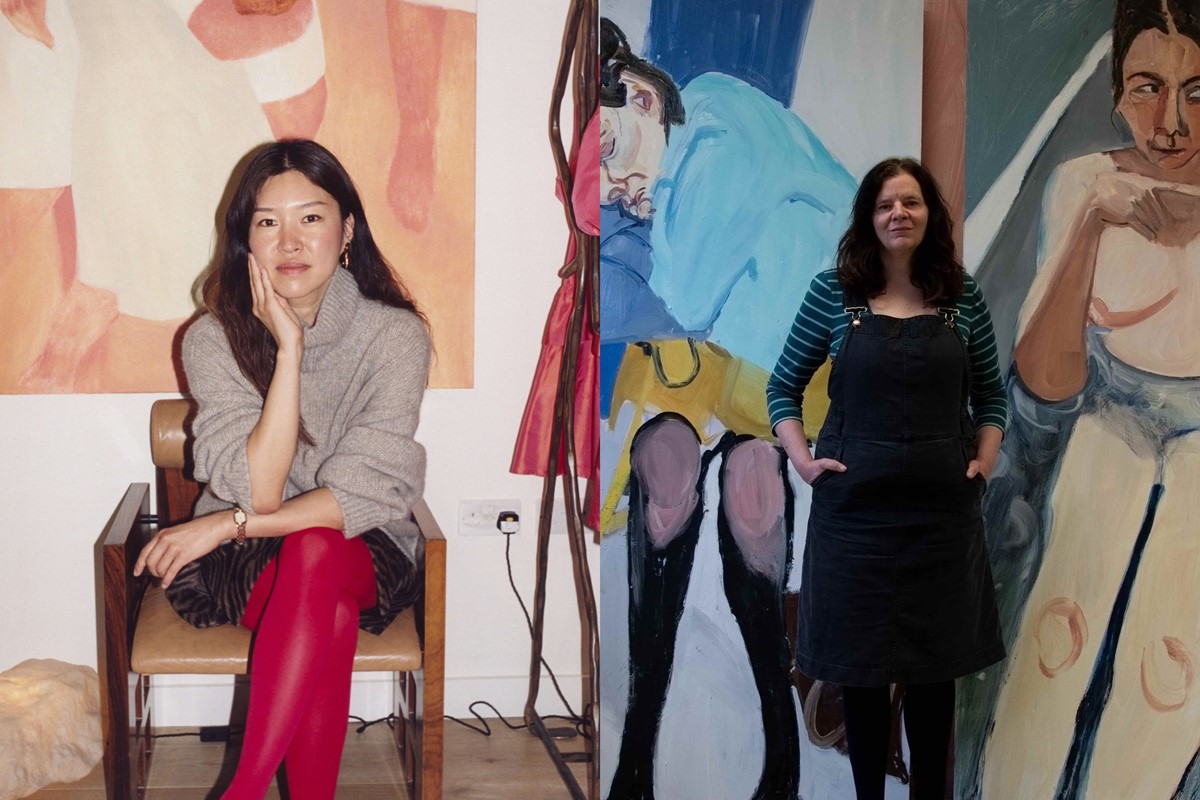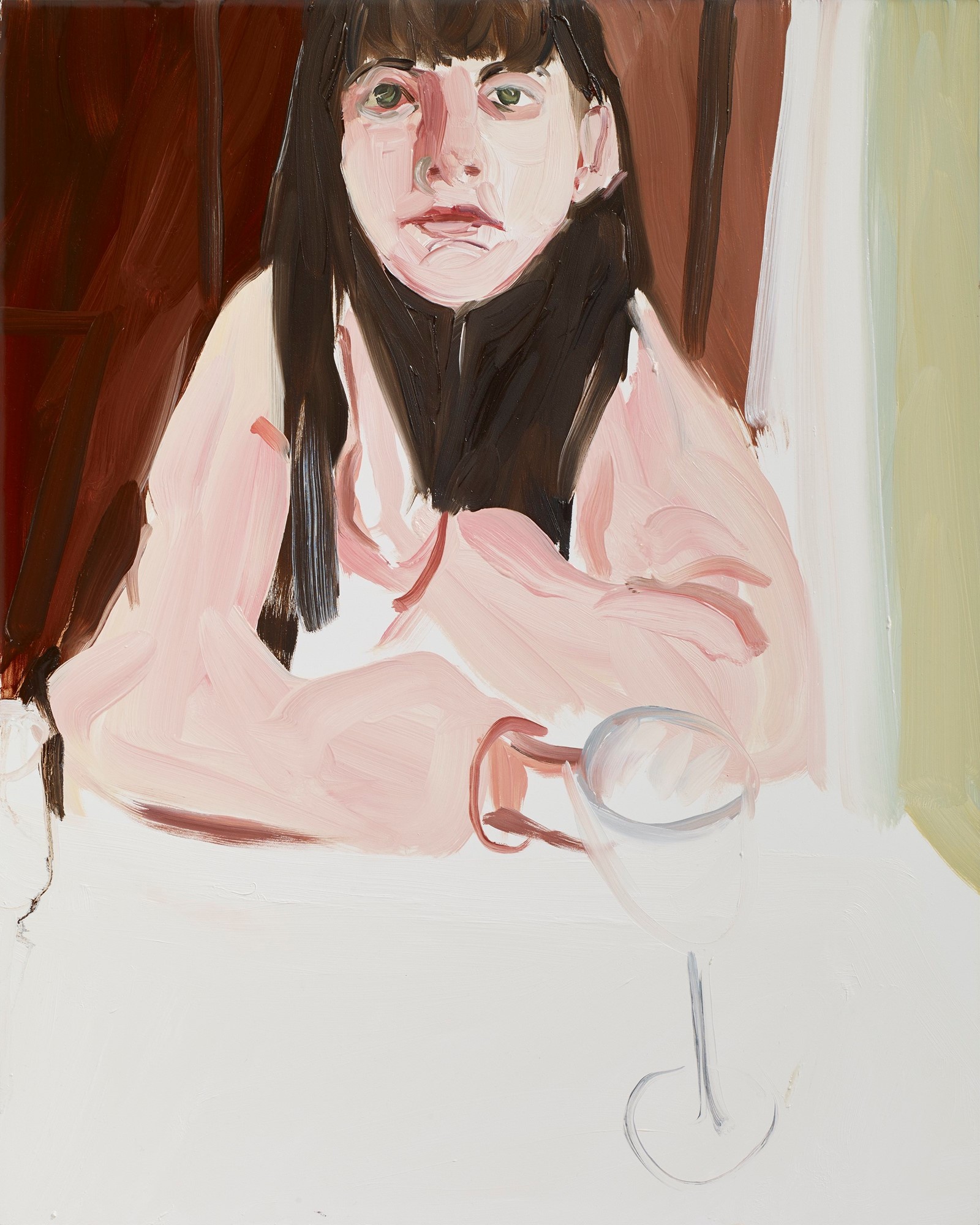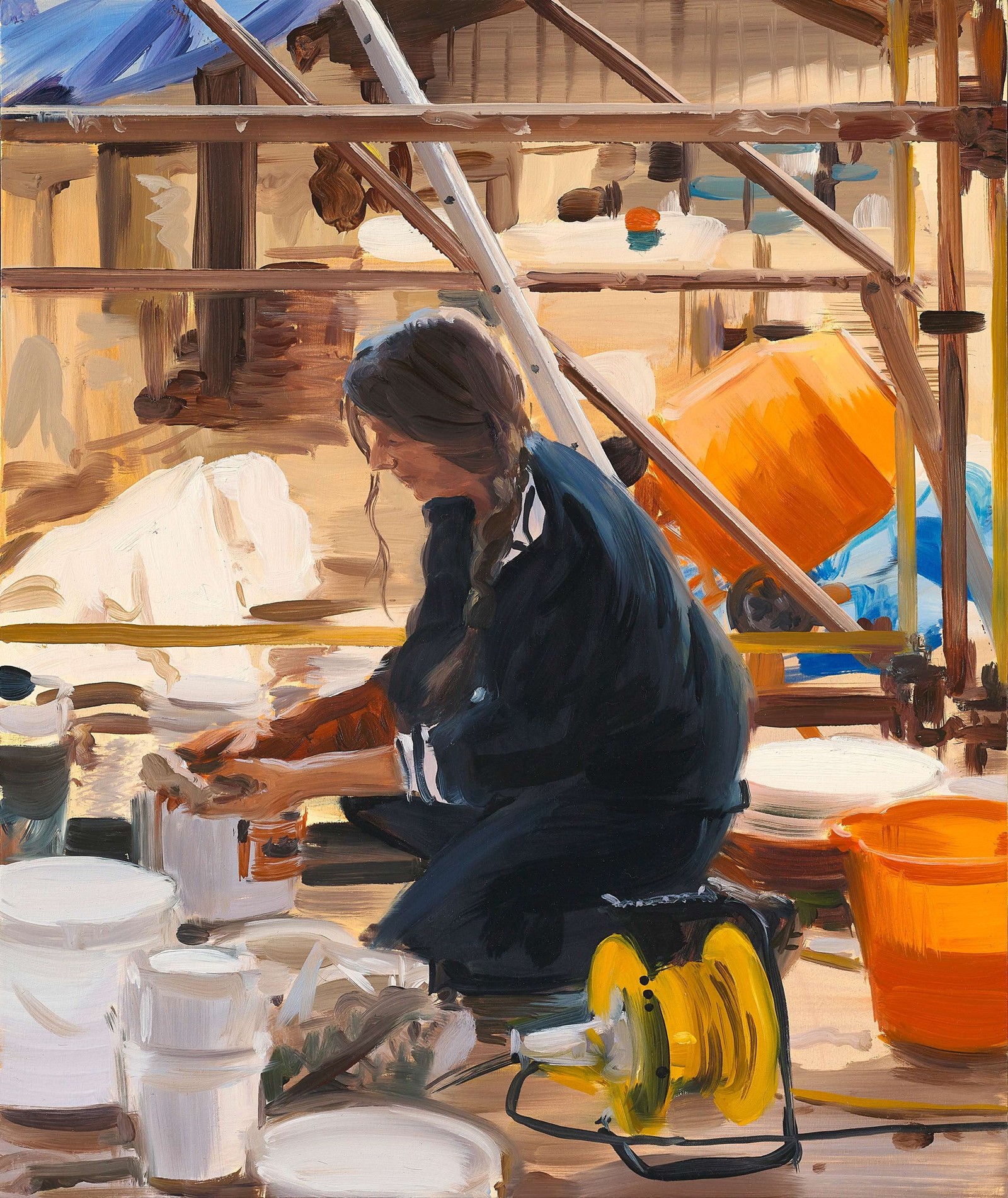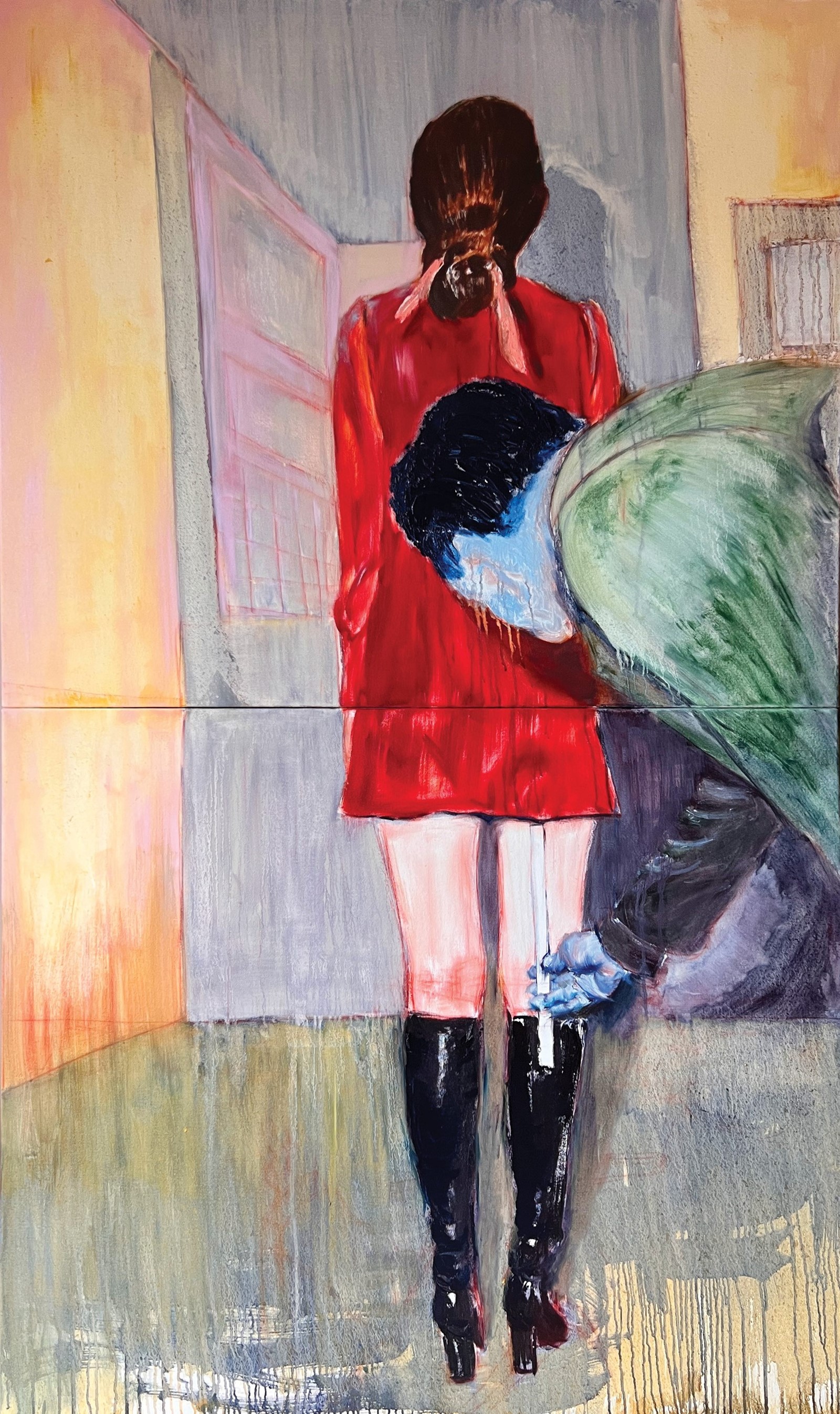
Rewrite
Lead ImageLeft: Rejina Pyo by Jukka Ovaskainen
Right: Chantal Joffe by Isabelle Young
When Rejina Pyo launched her eponymous label ten years ago, she had no expectations of what would come. “I started without really knowing what it involved,” she laughs. “But that naivety is kind of beautiful. I just wanted to make beautiful things that women can actually wear and not suffer in.” To mark the anniversary of her brand, Pyo has curated a group show, As She Is, with works from the likes of Chantal Joffe, Rachel Cusk, Caroline Walker, Angela de la Cruz, Antonia Showering, and Eileen Cooper, as well as the designer’s own paintings and installation.
Through the exhibition, which is currently on show at London’s Soho Revue Gallery, Pyo asks what self-acceptance as a woman could really feel like in the face of external narratives that constantly collude against the lived reality of womanhood. “I think more and more we put ourselves in a box out of fear of being judged,” she explains. “So I hope this different way of expressing selves can inspire others to have the courage to do what they are thinking.”
In celebration of the exhibition and ten years of Pyo’s timeless designs, the designer caught up with painter Chantal Joffe, whose emotional figurative explorations of female appearances feature in the show, and have long shaped Pyo’s own considerations of beauty and acceptance.
Below, the pair discuss the influence of each other’s work on their sense of self, the importance of intergenerational community, and the ongoing fight for women’s equality.
Rejina Pyo: I’ve known your work for a long time, Chantal. I’ve listened to your podcasts, I’ve watched all your YouTube videos, including the one of you doing a collage for like two hours. I just have always loved how real and generous and nurturing you are.
Chantal Joffe: I think you first invited me to a show about over a year ago … it was the one at Old Street? I was really struck by how the clothes weren’t sexist, but they were designed for women. They were beautiful and you wanted to wear them – they weren’t just for display.

RP: I remember seeing your painting of Katy Hessel at her book signing at Victoria Miro Gallery. She told me “Oh, Chantal requested that I wear your red dress to sit for her.” And well, my love just grew.
CJ: I love that dress. It’s a bit like the Botticelli painting when the woman is coming out of the clam shell, and Katie kind of emerged from the red dress. There was something about that dress … it was a strange day. Katy and I were both feeling a bit fragile. I’d had a weird thing happen where on the way to the studio, I’d tripped and cut my hand on the pavement, and it was bleeding. I remember thinking it was oddly apt. Clothes can really augment how people are feeling.
I definitely feel a connection with your clothes. I mean, I’m not a young woman but I feel really good in them. They are not just for beautiful, skinny young women to wear. That’s radical for me.
“Isn’t art also a way to be in the moment? For me, painting is the only time I can be present” – Chantal Joffe
RP: I feel the same with your work. I remember when you were talking about doing self-portraits during Covid and you said that, when people saw the show, they said something like, “Oh you’re not as bad looking as this.” I don’t know if anyone would say that to a male artist! We’re so used to beautifying females in some way, in fashion and in art history. But I guess this comes back to the exhibition, As She Is. Accepting what is and finding the beauty in it. That’s how I see your work.
CJ: I also wanted to say, Rejina, that whenever I go to a meal or show that you have planned, you always bring the most amazing women together from all different places. And we’re often all dressed by you and we’re carrying really great handbags that you’ve given us. I meet people I’d otherwise never meet – it’s great.

RP: What I’ve learnt is that you don’t do things on your own. Even though we all do need time to just sit with ourselves, with the uncomfortable silence, to connect with the voice inside you, I just love people and getting to know what they do, their whole life experiences. So I love to create this community of women where we can all appreciate each other. This exhibition is in that spirit. We really need to have that interaction with different generations and different bubbles. Otherwise, we are imprisoned by the algorithm.
CJ: Absolutely. I really love that the people who come sit for me are often a lot younger or a lot older. It feels really important to hear voices, that, as you say, are not in an algorithm. I love to hear what my daughter, who’s 20, and her friends are saying. It stops you from being set in your ways. I have a friend who’s older than me and she taught me a lot about not just living in your little unit and hearing the same voices and opinions, but trying to understand a different position, a different place in the world and how it feels.
RP: I really agree. That’s why I love meeting new people and maybe that’s why my collections feel more inclusive. It’s my way of supporting women because sometimes we don’t have much choice. Like you said, there are very narrow visions of what a woman should be. Your work offers the same thing, Chantal – that it’s OK to be who you are. But I guess that’s the power of art and artists.
CJ: Isn’t art also a way to be in the moment? For me, painting is the only time I can be present. I think the internet doesn’t help with all that, the constant future planning and imagining, consuming and showing. It’s what I loved at the opening of As She Is, that people had styled your clothes to suit them and not the Internet. People had really messed them up in the best possible way.

RP: Oh, I love seeing how people translate my clothes in their own way. And I think we need this exchange of ideas more than ever to get out of the algorithm. Because for women, everybody is obsessed with when we are in our twenties, and we live with a huge pressure to look like that forever. It takes away from all that we can do.
I remember when I got my period, I asked my mum for surgery, so I didn’t have to have it. I just thought: this is ridiculous! Women have to do this every month? And brush our hair, put on make-up, look presentable? I thought, “No wonder there are no female presidents or CEOs if we have to do all of this.” It’s taking a really long time to get away from that, but I think we are. Baby steps. One step at a time.
“We really need to have that interaction with different generations and different bubbles. Otherwise, we are imprisoned by the algorithm” – Rejina Pyo
CJ: You’re so right, Rejina. It’s extraordinary what women do. I often think that women are like that game Buckaroo!, with the donkey who is loaded up with things until he bucks. They’re trudging along, doing all of these incredible things while people are just putting more and more things, more and more responsibilities on them. And you can never take for granted that any changes will be permanently enshrined in law. Each generation has to fight anew for equality.
RP: You remember my painting that’s in the show, about men measuring women’s skirts? That was from the 1970s in Korea, but when I was researching, I found that it was still happening today in parts of the world. There are so many ridiculous, unfathomable things happening to women. But I think every day is a kind of progress.
Chantal, what do you do when you’re feeling blocked or frustrated?

CJ: The best thing always is to go to the National Gallery or open an art book. Go back to the source.
RP: I’m similar to you. I just have to go to galleries. It’s like a cleanse for your eyes and mind. And you know, Chantal, you’re a huge inspiration, not just for our generation, but also for the generations to come.
CJ: I think anybody who makes anything is very, very lucky. To be able to make something that we are all able to engage with is a great, great privilege.
As She Is, a group show curated by Rejina Pyo, is currently on show at Soho Revue in London until 2 November 2024.
in HTML format, including tags, to make it appealing and easy to read for Japanese-speaking readers aged 20 to 40 interested in fashion. Organize the content with appropriate headings and subheadings (h1, h2, h3, h4, h5, h6), translating all text, including headings, into Japanese. Retain any existing
tags from
Lead ImageLeft: Rejina Pyo by Jukka Ovaskainen
Right: Chantal Joffe by Isabelle Young
When Rejina Pyo launched her eponymous label ten years ago, she had no expectations of what would come. “I started without really knowing what it involved,” she laughs. “But that naivety is kind of beautiful. I just wanted to make beautiful things that women can actually wear and not suffer in.” To mark the anniversary of her brand, Pyo has curated a group show, As She Is, with works from the likes of Chantal Joffe, Rachel Cusk, Caroline Walker, Angela de la Cruz, Antonia Showering, and Eileen Cooper, as well as the designer’s own paintings and installation.
Through the exhibition, which is currently on show at London’s Soho Revue Gallery, Pyo asks what self-acceptance as a woman could really feel like in the face of external narratives that constantly collude against the lived reality of womanhood. “I think more and more we put ourselves in a box out of fear of being judged,” she explains. “So I hope this different way of expressing selves can inspire others to have the courage to do what they are thinking.”
In celebration of the exhibition and ten years of Pyo’s timeless designs, the designer caught up with painter Chantal Joffe, whose emotional figurative explorations of female appearances feature in the show, and have long shaped Pyo’s own considerations of beauty and acceptance.
Below, the pair discuss the influence of each other’s work on their sense of self, the importance of intergenerational community, and the ongoing fight for women’s equality.
Rejina Pyo: I’ve known your work for a long time, Chantal. I’ve listened to your podcasts, I’ve watched all your YouTube videos, including the one of you doing a collage for like two hours. I just have always loved how real and generous and nurturing you are.
Chantal Joffe: I think you first invited me to a show about over a year ago … it was the one at Old Street? I was really struck by how the clothes weren’t sexist, but they were designed for women. They were beautiful and you wanted to wear them – they weren’t just for display.

RP: I remember seeing your painting of Katy Hessel at her book signing at Victoria Miro Gallery. She told me “Oh, Chantal requested that I wear your red dress to sit for her.” And well, my love just grew.
CJ: I love that dress. It’s a bit like the Botticelli painting when the woman is coming out of the clam shell, and Katie kind of emerged from the red dress. There was something about that dress … it was a strange day. Katy and I were both feeling a bit fragile. I’d had a weird thing happen where on the way to the studio, I’d tripped and cut my hand on the pavement, and it was bleeding. I remember thinking it was oddly apt. Clothes can really augment how people are feeling.
I definitely feel a connection with your clothes. I mean, I’m not a young woman but I feel really good in them. They are not just for beautiful, skinny young women to wear. That’s radical for me.
“Isn’t art also a way to be in the moment? For me, painting is the only time I can be present” – Chantal Joffe
RP: I feel the same with your work. I remember when you were talking about doing self-portraits during Covid and you said that, when people saw the show, they said something like, “Oh you’re not as bad looking as this.” I don’t know if anyone would say that to a male artist! We’re so used to beautifying females in some way, in fashion and in art history. But I guess this comes back to the exhibition, As She Is. Accepting what is and finding the beauty in it. That’s how I see your work.
CJ: I also wanted to say, Rejina, that whenever I go to a meal or show that you have planned, you always bring the most amazing women together from all different places. And we’re often all dressed by you and we’re carrying really great handbags that you’ve given us. I meet people I’d otherwise never meet – it’s great.

RP: What I’ve learnt is that you don’t do things on your own. Even though we all do need time to just sit with ourselves, with the uncomfortable silence, to connect with the voice inside you, I just love people and getting to know what they do, their whole life experiences. So I love to create this community of women where we can all appreciate each other. This exhibition is in that spirit. We really need to have that interaction with different generations and different bubbles. Otherwise, we are imprisoned by the algorithm.
CJ: Absolutely. I really love that the people who come sit for me are often a lot younger or a lot older. It feels really important to hear voices, that, as you say, are not in an algorithm. I love to hear what my daughter, who’s 20, and her friends are saying. It stops you from being set in your ways. I have a friend who’s older than me and she taught me a lot about not just living in your little unit and hearing the same voices and opinions, but trying to understand a different position, a different place in the world and how it feels.
RP: I really agree. That’s why I love meeting new people and maybe that’s why my collections feel more inclusive. It’s my way of supporting women because sometimes we don’t have much choice. Like you said, there are very narrow visions of what a woman should be. Your work offers the same thing, Chantal – that it’s OK to be who you are. But I guess that’s the power of art and artists.
CJ: Isn’t art also a way to be in the moment? For me, painting is the only time I can be present. I think the internet doesn’t help with all that, the constant future planning and imagining, consuming and showing. It’s what I loved at the opening of As She Is, that people had styled your clothes to suit them and not the Internet. People had really messed them up in the best possible way.

RP: Oh, I love seeing how people translate my clothes in their own way. And I think we need this exchange of ideas more than ever to get out of the algorithm. Because for women, everybody is obsessed with when we are in our twenties, and we live with a huge pressure to look like that forever. It takes away from all that we can do.
I remember when I got my period, I asked my mum for surgery, so I didn’t have to have it. I just thought: this is ridiculous! Women have to do this every month? And brush our hair, put on make-up, look presentable? I thought, “No wonder there are no female presidents or CEOs if we have to do all of this.” It’s taking a really long time to get away from that, but I think we are. Baby steps. One step at a time.
“We really need to have that interaction with different generations and different bubbles. Otherwise, we are imprisoned by the algorithm” – Rejina Pyo
CJ: You’re so right, Rejina. It’s extraordinary what women do. I often think that women are like that game Buckaroo!, with the donkey who is loaded up with things until he bucks. They’re trudging along, doing all of these incredible things while people are just putting more and more things, more and more responsibilities on them. And you can never take for granted that any changes will be permanently enshrined in law. Each generation has to fight anew for equality.
RP: You remember my painting that’s in the show, about men measuring women’s skirts? That was from the 1970s in Korea, but when I was researching, I found that it was still happening today in parts of the world. There are so many ridiculous, unfathomable things happening to women. But I think every day is a kind of progress.
Chantal, what do you do when you’re feeling blocked or frustrated?

CJ: The best thing always is to go to the National Gallery or open an art book. Go back to the source.
RP: I’m similar to you. I just have to go to galleries. It’s like a cleanse for your eyes and mind. And you know, Chantal, you’re a huge inspiration, not just for our generation, but also for the generations to come.
CJ: I think anybody who makes anything is very, very lucky. To be able to make something that we are all able to engage with is a great, great privilege.
As She Is, a group show curated by Rejina Pyo, is currently on show at Soho Revue in London until 2 November 2024.
and integrate them seamlessly into the new content without adding new tags. Ensure the new content is fashion-related, written entirely in Japanese, and approximately 1500 words. Conclude with a “結論” section and a well-formatted “よくある質問” section. Avoid including an introduction or a note explaining the process.


